Take two hits of Maui Wowie and call me in the morning: Baby boomers in the age of medical marijuana
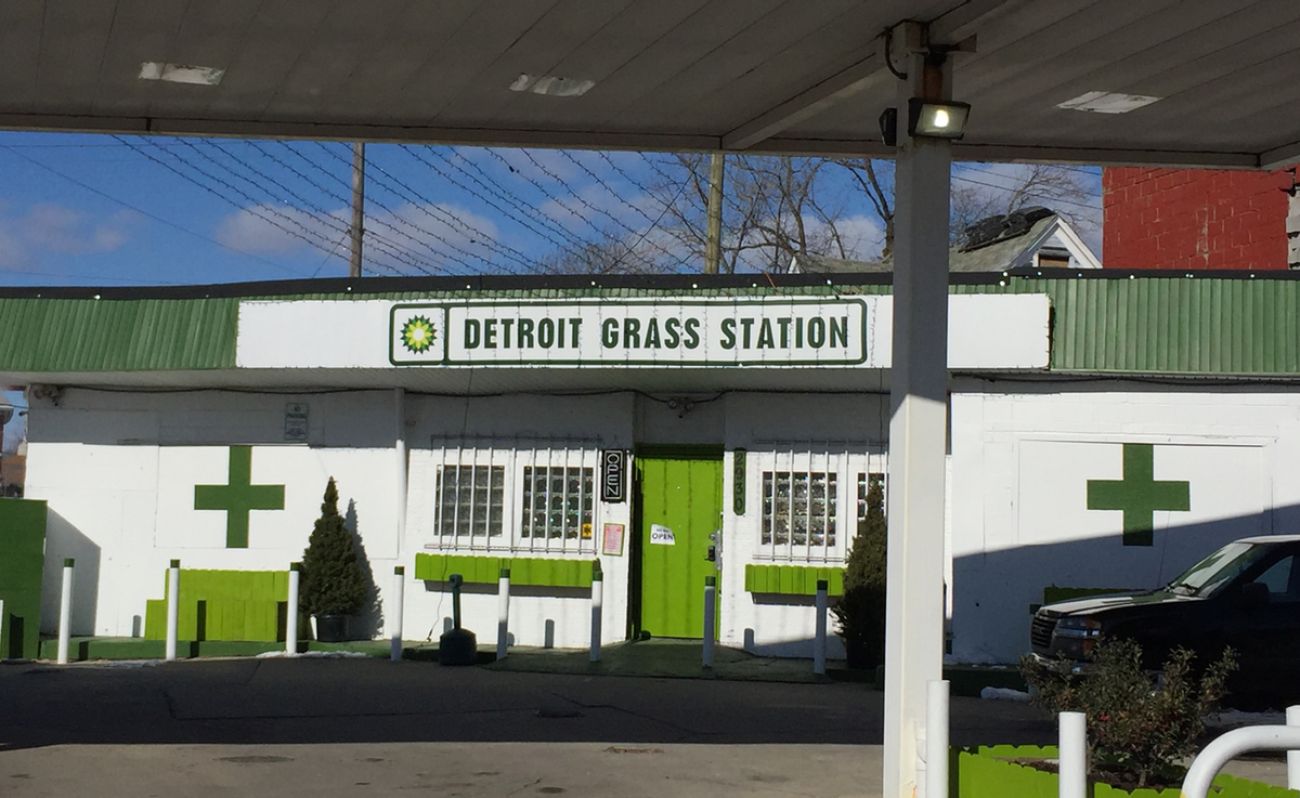
After years of driving past and wondering what happens behind the door, I’m behind the door.
I’ve done my prep work. I’ve told no lies. I think I know what I’m in for, but when the buzzer sounds, the lock clicks and I step into this fragrant, blue-and-green-lit space, I realize I’m still flummoxed.
Do I want Don Draper or Blue Dream? Gorilla Kush OG or Cannatonic? Indica or sativa or hybrid? Edible, smokable or vapable? Why is there a picture of Detroit Mayor Mike Duggan over by the...what is that stuff? Popcorn?
I’m in a medical marijuana dispensary in Detroit, not far from my home in Grosse Pointe. I’m here for my medicine. But this medicine is like no other. I feel like this place is at least half a joke and I’m not sure if I’m the punchline, an aging baby boomer with bad knees, who has come full circle from gleeful recreational use in the 1970s through years of never touching the stuff, back to looking at marijuana from an entirely different angle. As medicine. Or as “medicine,” like your grandmother used to refer to her martini.
And true to all boomer mythology, I’m metaphorically bringing a bunch of friends along; the U.S. Centers for Disease Control and Prevention says Americans aged 55-64 are the fastest-growing group of users in the country, outpacing their 18-25-year-old children and grandchildren. Since 2002, use has more than quadrupled among those ages 55 to 64 and tripled among those 65 and older, the CDC reports. That’s true in Michigan as well, as a recent study by University of Michigan psychiatrists found while hanging out at a marijuana clinic.
A doctor has sent me to the dispensary, but beyond a brief discussion about types of marijuana and one of its key extracts I have to figure this stuff out for myself. The guy behind the counter at the dispensary is a “caregiver,” but he doesn’t know me and hasn’t seen me in a paper gown. He’s sort of like a pharmacist, but I didn’t arrive with a prescription, only permission.
I can’t figure out if this is 21st-Century health care (I will learn along the way that many medical marijuana users have significant pain and are avoiding opiates), alternative medicine or, like I said, one big joke, legalization of recreational pot via the side door.
And more than 218,000 of my fellow Michiganians stand with me as fellow holders of the card that gets us past the buzzer. For six years, those numbers have been climbing, with medical and otherwise legal marijuana one factor keeping the middle-aged stoned well into their Barcalounger years.
From the looks of the people I see on visits to dispensaries, they include healthy-looking young people whose biggest problem appears to be acne, but also older people leaning on canes. I see middle-aged women much like myself, younger ones who could be my daughter. Black folks, white folks, hipsters, club-kid types, the whole human family as it exists in southeast Michigan in 2017.
So, how did I, how did we, get here?
Like I said: My knees hurt.
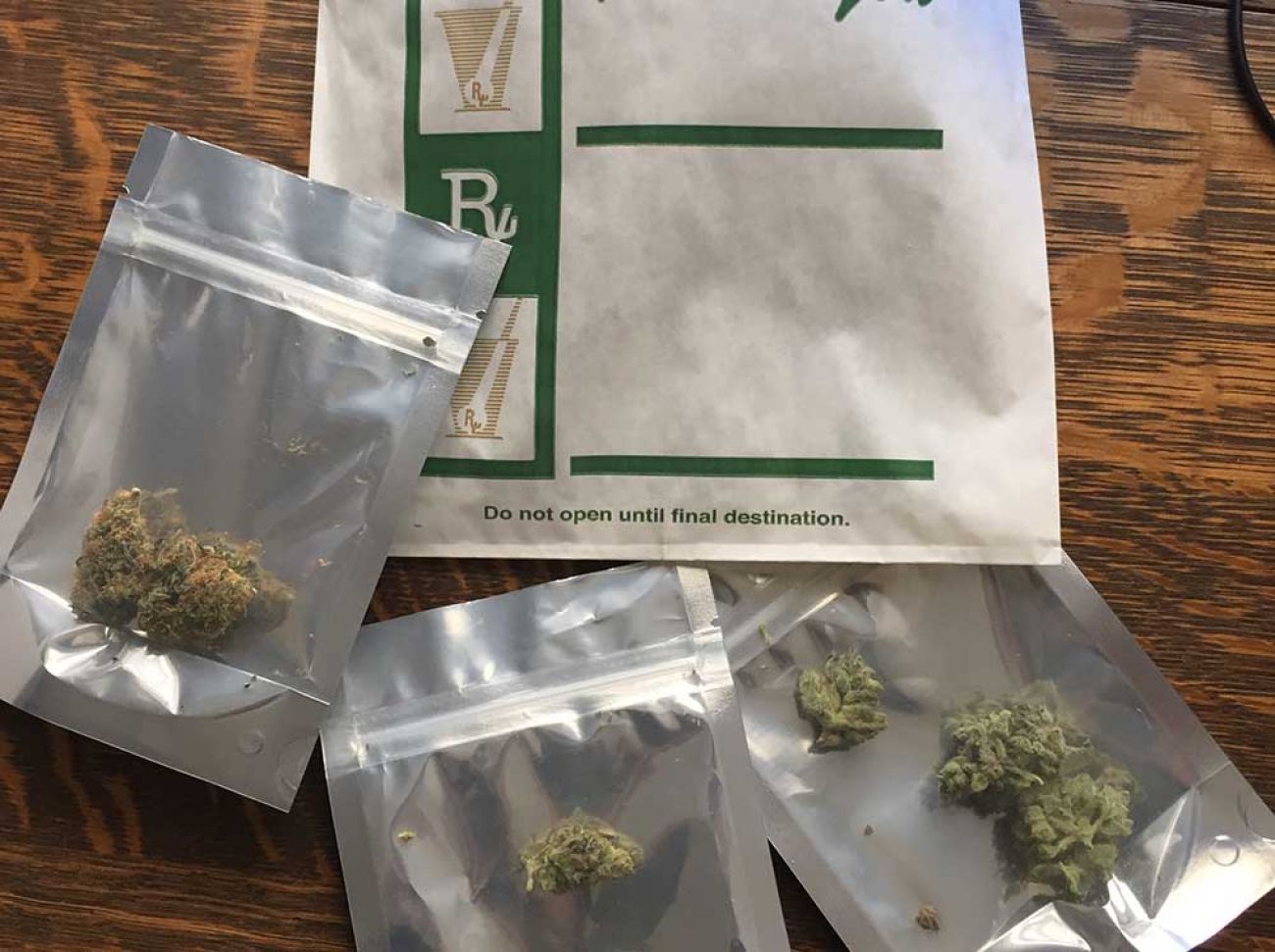
The doctor is in
Three years ago, an orthopedist X-rayed both joints, diagnosed arthritis and casually informed me I was a whisker away from bone-on-bone and overdue for a double knee replacement. I left his office without making another appointment, appalled at both my advancing age and his la-di-da attitude toward such major surgery. The pain has waxed and waned since, but as long as I remain opposed to surgery, my options appear limited to drugs and stoicism.
The pain is lessened by ibuprofen. But ibuprofen is bad for your stomach and long-term use carries a range of nasty side effects. Opiates? Forget it. And that’s how my interest turned to the green crosses I see in my perambulations around Detroit, at places like the Detroit Grass Station, the Reef, the House of Dank and Cannabliss.
Of course I’d used marijuana earlier in life. It was our generation’s bathtub gin. No one tried to pretend it had any use as medicine, except maybe as a way to enhance music appreciation; Pink Floyd’s entire career was predicated on a profoundly stoned fan base, I’m convinced.
But life moves on, bringing graduation, jobs, children, urine tests. Socializing moved from basement rec rooms and dorms to bars and restaurants. Alcohol was legal, weed wasn’t, and I chose social acceptance. Within a few years, I was so out of it that pot references in pop culture flew miles over my head: Dr. Dre’s new record is called “The Chronic?” Chronic what? Is he sick?
Meanwhile, selective breeding and indoor growing was producing plants with far higher levels of its active ingredient, THC. This new stuff was ridiculously strong, not the giggly social lubricant of the ‘70s, but an energy-sapping force that pinned you to the couch like a butterfly to a board.
Other things were changing as well. With indoor growing had come a movement toward legalization, with the medical benefits as a stalking horse. Marijuana, studies claim, has promise for treating a wide range of health conditions. And baby boomers aged into positions of responsibility, their pasts trailing behind. In 1987, Douglas Ginsburg was pressured into withdrawing from a Supreme Court nomination because he’d smoked dope years before. By the time Barack Obama emerged in public life in 2004, he practically smelled like weed smoke, from his days sparking up in the Choom Wagon with the gang back in Hawaii.
There was more: I started knowing more people directly touched by cancer, and a few used marijuana to soften the edges of some very rough passages. They came away believers in the value of this drug and testified to its benefits with far more enthusiasm than they did, say, chemotherapy.
By the time Michigan voters approved the use of medical marijuana in a citizens’ initiative in 2008, it was clear we were in a new world, one where state Court of Appeals judges could make pot references in their opinions, as Judge Peter J. O’Connell did two years later, trying to untangle the citizens initiative:
“Reading this act is similar to participating in the Triwizard Tournament described in J.K. Rowling’s Harry Potter and the Goblet of Fire: the maze that is this statute is so complex that the final result will only be known once the Supreme Court has had an opportunity to review and remove the haze from this act.”
It’s almost like the people who wrote it were stoned when they did so.
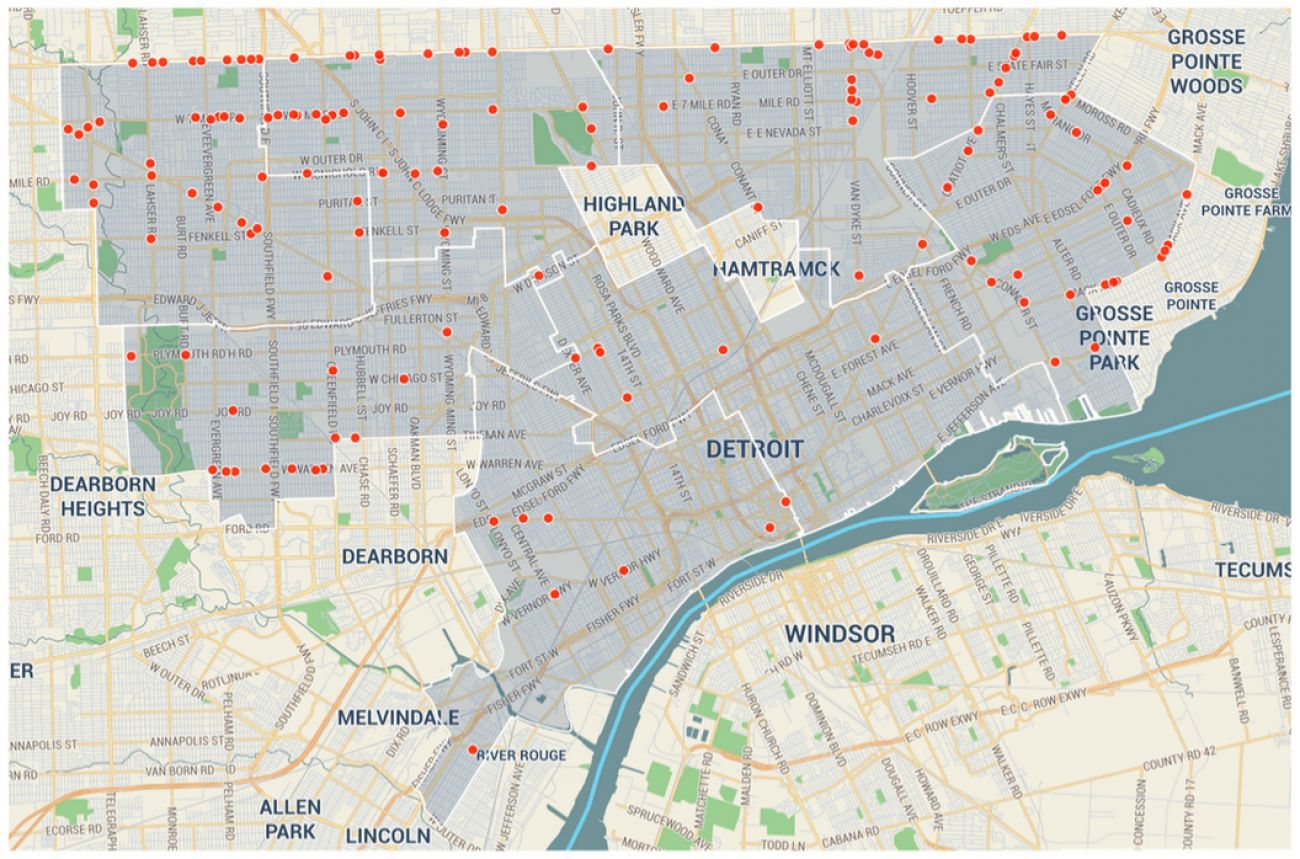
A new world, and it smells funny
The list of conditions approved for medical-marijuana use contains the sorts of things I would fall on my arthritic knees and thank heaven do not afflict me: Cancer, AIDS, HIV, hepatitis C, ALS, Crohn’s disease, nail patella, glaucoma.
But there’s a second list of symptoms and there was my ticket: chronic pain. Pain is a perfect symptom for what doctors call drug-seeking behavior, because it can’t be verified or quantified by anyone other than the person feeling it. And I feel it. In my knees.
My family doctor laughed and said he had no problem with me self-medicating, but he wasn’t going to put his name anywhere near an official document giving me permission. So I went back to a Mack Avenue dispensary and asked for a recommendation. And that was how I found myself in a Sterling Heights office building, having a medical experience that was both familiar (history, blood pressure, forms to fill out) and unfamiliar, in that no one asked about my insurance, and the $100 fee was payable in cash only.
The doctor entered the room with the authority of a baby-boom Marcus Welby, only, you know, cool. There was never any shilly-shallying about why I was there; I explained about my knees and told him I was interested in cannibidiol, or CBD, the latest thing in cannabis medicine, a zero-THC extract that is said to give marijuana’s benefits without the high. We spent most of our time discussing vape pens and indica vs. sativa strains of weed.
“It’s like Cheech and Chong went to med school,” I marveled.
He never told me I was approved before he left the room. But I was. A nurse came in with my paperwork in a couple of envelopes – one to the state to get my card, the other duplicates that I could take to a dispensary to get my medicine, more or less immediately after writing a $60 check to the state and sending it via certified mail.
And that’s how easy it was to become a patient.
But this is being a patient like no other. Other than the conversation about vaping CBD, there was no sense of how and how much I should be using. When my family doctor writes me a prescription, it’s for a specific drug made under laboratory conditions. There’s a dosage, warnings, a child-proof cap.
No such guidance exists for marijuana. Once you have your card, it’s up to you to figure it out, via trial, error, advice and internet research. It won’t have medicinal names; you’ll have to ask for Pink Panties or Blueberry Headband, Sour Diesel or White Rhino, and let’s not forget Death Star.
And about those dispensaries: They are, in the opinion of Attorney General Bill Schuette and much of law enforcement, illegal. Marijuana itself is illegal under federal law. For now – and perhaps for not much longer – the federal government isn’t enforcing the law in the 26 states that permit medical or recreational use (plus the District of Columbia). In Michigan, some cities tolerate them, and some don’t. You can find them on the Detroit side of 8 Mile Road, but not on the other, because Oakland County’s police agencies don’t allow them. You can find them in Flint, but not Grand Rapids, Ypsilanti but not Dearborn.
On Mack Avenue, the artery that divides the Grosse Pointes from Detroit, dispensaries sprouted like...OK, weeds. At one point, I counted seven in a three-mile stretch.
Essentially, said Matt Abel, a Detroit lawyer whose practice is exclusively marijuana-based, dispensaries operate like mice in a house with a cat who has better things to do.
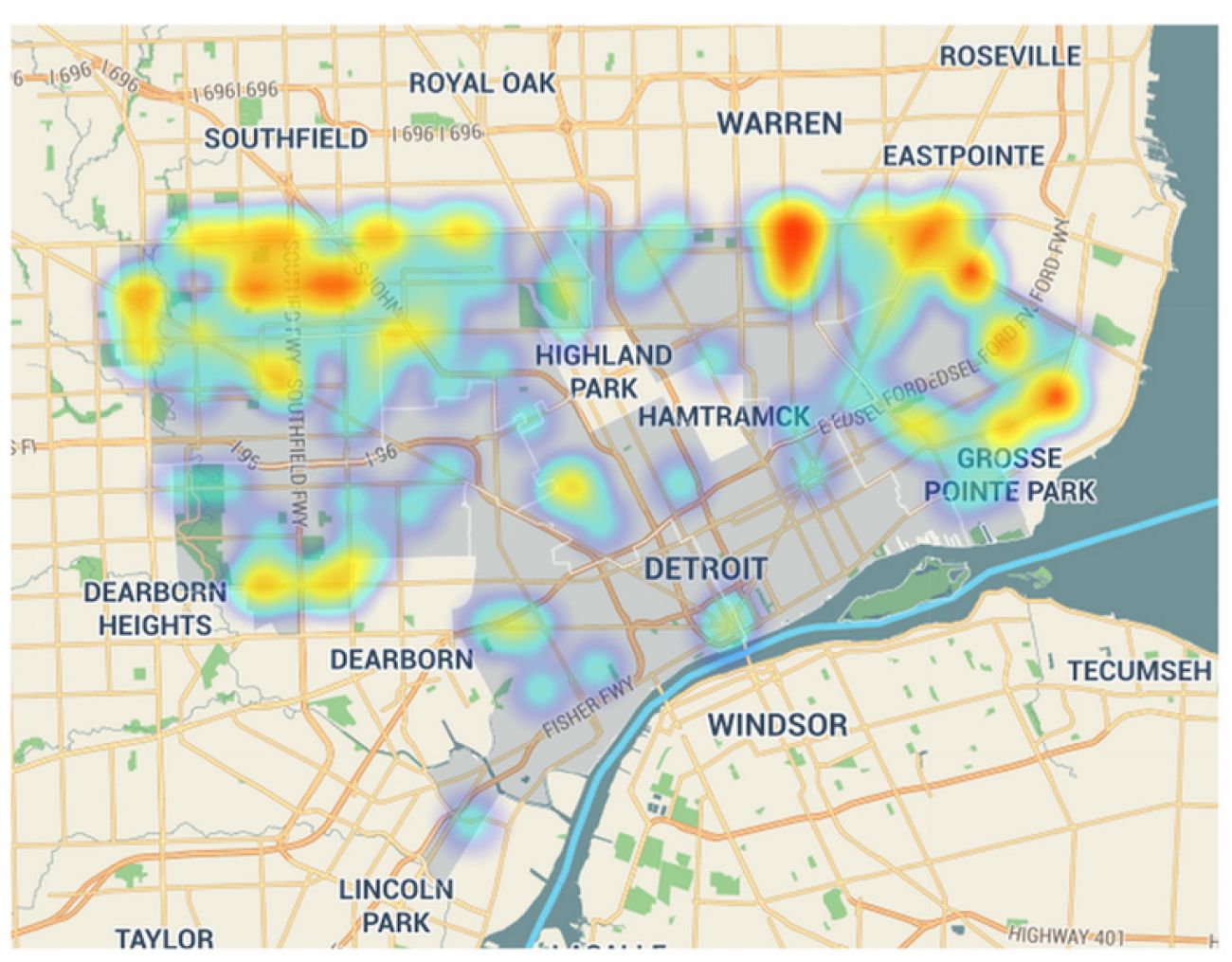
The new speakeasies
This can make for an unstable business environment. When Loveland Technologies, a Detroit-based company that maps individual property parcels in the city, set out to map all the dispensaries there, they consulted no state database, because none exists. Rather, Loveland used independent online sources like Weedmaps and their employees’ own eyes to get an admittedly imprecise estimate of how many were operating.
Loveland’s 2015 report, “Weed in the D,” identified 152 dispensaries “currently or recently operating” in Detroit, with most about a mile from its suburbs, on border streets near Southfield and Dearborn, Grosse Pointe and Warren.
Some keep a lower profile; others display the green cross that has become a universal symbol for medical marijuana. Most are in small storefronts or other converted structures. Abel said a well-located, well-run dispensary can gross tens of thousands of dollars a day.
Lately, many are facing closure, following the passage of a 2015 city ordinance written to get them farther away from schools, churches and parks. It took effect in March 2016 and dispensaries have been working through zoning-board appeals and various legal actions, buying time before a new set of state laws take effect this year to license and tax the production and sale of marijuana in Michigan.
“The city tolerated a lot of behavior (early after the law’s passage),” said Travis Copenhaver, a Lansing-based lawyer who recently represented the Detroit Grass Station in an unsuccessful zoning appeal. (It’s 100 feet too close to a playground.) “A lot of facilities are probably not compliant. Roughly six years later, the city decides to do something about it.”
That’s bad news for the Grass Station. Copenhaver said his client is “evaluating the options,” going forward.
Its operation is typical of the dispensaries I visited. Stepping through the outer door takes you to an anteroom, where you wait if the dispensary is crowded, or if you’re accompanying a cardholder but don’t have one of your own. At the Reef, probably the nicest place I visited, you can read InStyle magazine, help yourself to free coffee, watch TV or enjoy the action in an enormous, wall-mounted saltwater fish tank that is the other reference in the place’s winking name.
You get into the actual dispensary by presenting your state-issued card IDing you as a marijuana patient, along with another ID. A clerk puts you in the dispensary’s database -- or checks your presence there, if you’re a repeat customer -- and buzzes you in.
People talk a lot about the smell of burning marijuana, but the first thing that hits you in a dispensary is its unburnt smell, the rich, redolent aromas of the plant itself, dried and displayed for purchase. Every dispensary I visited does it approximately the same, with a sample of each variety in an open Mason or apothecary jar on the counter, for patients to examine and breathe deeply from, inhaling the various odors – citrusy, fruity, skunky. As you shop, it’s hard not to feel like a wine snob choosing between a big red or a refreshing white.
In fact, there’s a lively supporting industry to help you sort this out. Google the name of any individual strain, and you’ll find web pages underlining the wine-snob vibe:
Crossing a Blueberry indica with the sativa Haze, Blue Dream balances full-body relaxation with gentle cerebral invigoration. ...With a sweet berry aroma redolent of its Blueberry parent, Blue Dream delivers swift symptom relief without heavy sedative effects.
Most varieties are sold by the gram – for around $10-$15 – or fraction of an ounce. Make your selection, pay your money and receive your medicine.
Seeds and sales
A timeline of medical marijuana in Michigan
November 2008: Proposal 1, a citizens’ initiative, passes with more than 60 percent of the vote in 2008, legalizing marijuana for medical use in the state.
October 2009: The U.S. Department of Justice issues a guidance memo to its U.S. attorneys in states where medical marijuana is approved, telling them not to “focus federal resources in your States on individuals whose actions are in clear and unambiguous compliance with existing state laws providing for the medical use of marijuana.” The drug remains illegal under federal law and on federal property.
2009-2010: Although the law covers only the patient-caregiver relationship, marijuana dispensaries – essentially stores open to anyone with a state-issued card – begin to open around Michigan.
June 2011: Attorney General Bill Schuette issues an opinion that patient-to-patient sales – an arrangement practiced at some dispensaries – are illegal. Some close. In other cities, including Detroit, dispensaries continue to operate as police choose not to enforce the law.
December 2012: The Legislature passes a package of bills clarifying aspects of the state law, including the doctor-patient relationship.
February 2013: In Michigan v. McQueen, the state Supreme Court agrees with Schuette. “This law is narrowly focused to help the seriously ill, not an open door to unrestricted retail marijuana sales,” Schuette said in a statement. “Dispensaries will have to close their doors.” Some do. Others don’t.
August 2016: Another ballot initiative, this one to legalize marijuana for recreational use, gathers steam before it is kept off the November ballot on a technicality, when the Michigan Court of Claims rules a portion of the signatures were gathered too early, rendering them “stale.”
2017: MI Legalize, the group organizing the legalization effort, continues to raise money and vows to make a second attempt for the 2018 midterm elections.
Green Michigan
It’s all bewildering to contemplate, especially for someone who remembers when the only varietals were Colombian Gold and Panama Red. You almost get the idea you’ve stumbled into a parallel Michigan that operates in a shadow.
And you have.
Howard Lutz is part of it, although his business is entirely legal. Iron Laboratories, in Oakland County’s Walled Lake, tests samples from growers, breaking down a particular crop by various cannabinoid levels, including THC and CBD. They also test for molds, insect infestations and other impurities. In six years, he estimates they’ve tested 100,000 samples, effectively serving as a cross between the Good Housekeeping Seal of Approval and the Food and Drug Administration. If Iron Labs says it’s good stuff, it’s backed up by science.
Lutz is looking forward to the new laws, which promise to bring some of these players into the bright light of full legality, along with a tidy revenue stream for the state. The 3 percent excise tax on dispensaries’ gross sales is expected to raise $21 million per year.
“The whole idea is to get rid of the gray areas and make it black and white,” Lutz said. “Essentially what has occurred from 2008 to six months ago (when the laws passed), was a series of trial and error. A lot of people got hurt, a lot made money. Without the clarity, it was a Frisbee game between the legislature, the courts and everybody else.”
The law will require commercially sold marijuana to go through testing like that at Iron Laboratories. While the business has been able to expand through this Frisbee game – Lutz has an outpost in Oregon, where recreational use is legal – he said he hopes the laws will encourage what the whole issue is supposed to be about, i.e., medical research..
“Our people here have masters’ (degrees) in science,” Lutz said. “They’re not a bunch of young recreationalists having fun with machines. Our role is serious. If you have a bad knee, and if you were trying to get off opiates, or had cancer, or an infant with seizures?”
Marijuana has promise for all these conditions, and more, he said.
The new laws won’t allow for the spread of dispensaries throughout the state. Cities that don’t want them don’t need to do anything to keep them out, Abel said, and those that do have to craft a local ordinance granting however many licenses they want to allow.
Abel said the legislation should sort out the confusing tangle they’re in now.
“People assume dispensaries are legal, because they’re all over the place,” he said. There’s also the thorny business of how they’re stocked; if dispensary owners buy from growers, they risk felony arrest.
The existing statute is such a mess, he said, that it’s perfectly legal for a caregiver to light a joint and pass it to a patient, but illegal for the patient to pass it back.
“The legal term for that,” Abel said, “is bullshit.”
I spoke to one caregiver, who cultivates the legal maximum of 72 plants at a time, 12 for each of five cardholders and 12 more for himself, perfectly legal under the law. He’s strict about his plant counts, and prominently labels various harvests “cured” or “uncured,” because that’s where it gets sticky. He can possess 2.5 ounces of cured – dried, smokable weed – per patient, but his harvests typically yield hundreds of pounds, which he sells, at considerable legal risk, to dispensaries.
When the licensing process opens in December, he plans to apply for a grower-processor license and be fully legal, “seed to sale.” He’s on the hunt for real estate where he can erect a hoop house for cold weather and an adjacent field where his plants can grow under the summer sky.
“I can start paying my taxes and be a normal human at that point,” he said. He’ll be happy with that. “Right now, I’m a fox crawling around in the woods.”
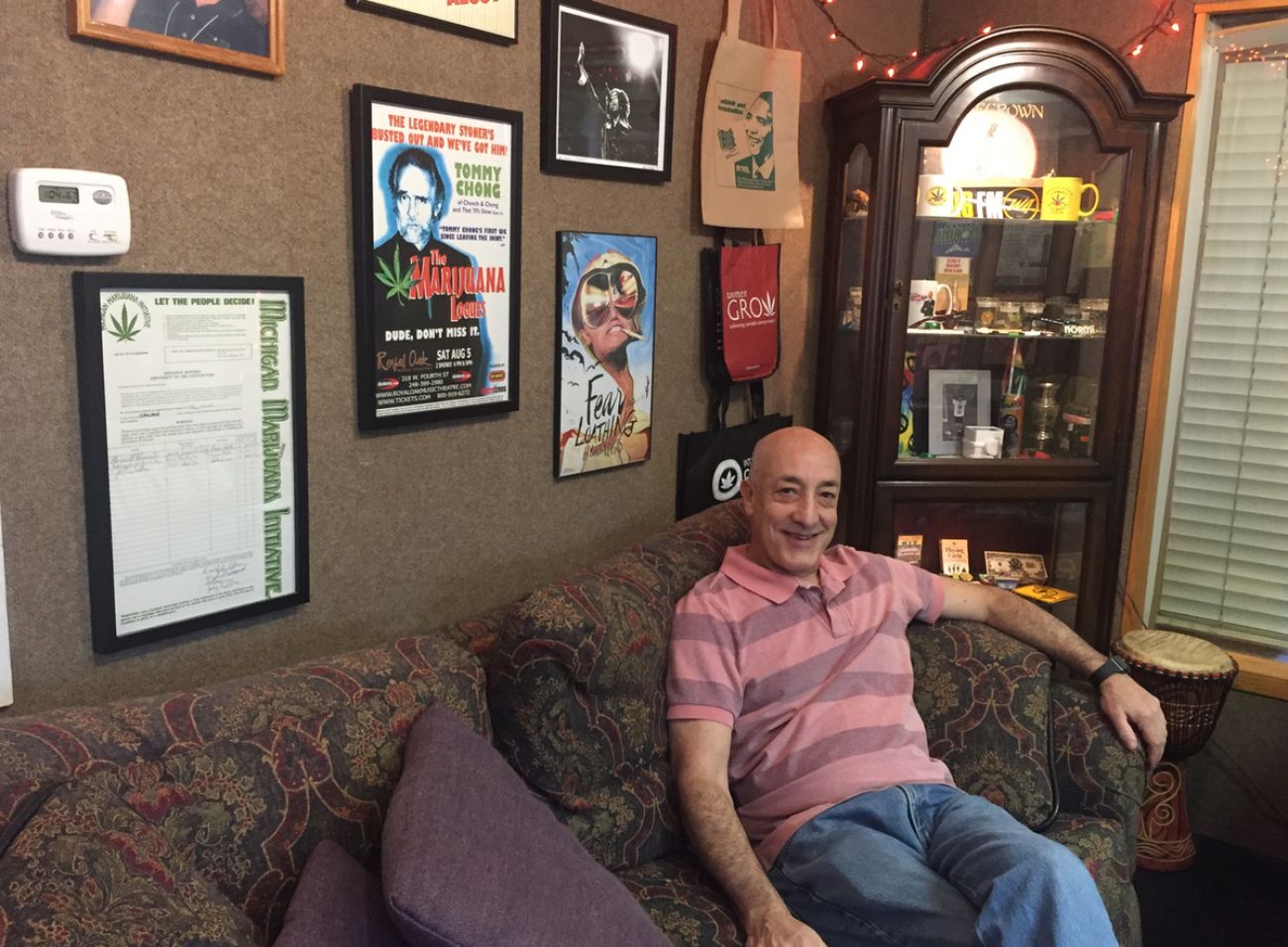
The verdict
So, maybe you’re wondering, how are those knees?
My first try was comedy. At the dispensary, I asked for and received a strain high in CBD, supposedly the miracle stuff. I didn’t realize that many high-CBD strains also have considerable THC, too. I packed a borrowed pipe and took three of what comedian Louis C.K. describes as “big, 1970s, denim-jacket, Bad Company-size hits.” An hour later, after burning dinner, petting my dog so much she finally slinked away to her bed and spending a little time doing the Twist, alone, in my living room, I thought to check in with my knees.
No change, but I was decidedly stoned and no longer cared.
Back to the dispensary, I got a zero-THC CBD extract and a similar edible, and can report it seemed to help. A little. But it cost way more than ibuprofen, and I can’t buy it with my health savings account money. Knee surgery is looking more and more inevitable.
In the meantime, my medicine chest is a lot more interesting.
I’d invite you over to sample it, but that would be against the law.
See what new members are saying about why they donated to Bridge Michigan:
- “In order for this information to be accurate and unbiased it must be underwritten by its readers, not by special interests.” - Larry S.
- “Not many other media sources report on the topics Bridge does.” - Susan B.
- “Your journalism is outstanding and rare these days.” - Mark S.
If you want to ensure the future of nonpartisan, nonprofit Michigan journalism, please become a member today. You, too, will be asked why you donated and maybe we'll feature your quote next time!

